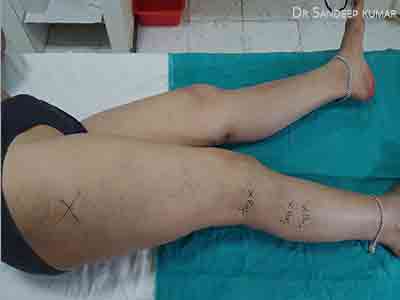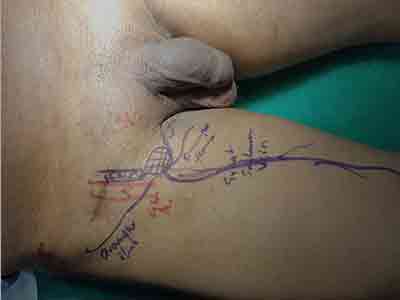Dr Sandeep Kumar’s Clinic offers best surgery services for Varicose Veins in Lucknow.
Our clinic deals with this problem of tortuous and enlarged veins that have become poor or sluggish conduits of blood return towards heart on account of damaged one way valves in the veins. There is also increased blood pressure in the veins called venous hypertension. This also leads to chronic leg pain, itching, eczema of the feet, ulcers and general fatigue, heaviness, swelling and aching pain. Varicose veins are distinguished from reticular veins (blue veins) and telangiectasias (spider veins), that are smaller veins also with insufficiency of the valves.
Diagnosis
Careful history and detailed examination generally establishes the diagnosis. It needs special attention and time spending to make accurate diagnosis of venous hypertension in the absence of varicose veins. Ultrasonic and colour Doppler studies are done to confirm our clinical findings.
What Causes Varicose Veins?
Varicose veins are a manifestation of venous insufficiency that is sluggish or poor return of blood. The function of a vein is to return blood to the heart and since the legs are far away and anti-gravity return is required, the varicose veins are most commonly seen in lower limbs.
Veins have one-way valves that allow the blood to flow towards heart and close when the blood column drops. Congenital since birth weakness leads to development of backflow of blood in 1-5% subjects causing venous insufficiency. High blood pressure in the veins and blood leakage leads to pigmentation, patchy dermatoses*, eczema** like condition and symptoms of aching leg pains.
*Lipodermatosclerosis – is a more serious complication that leads to hardened and tight skin, which may change colour to red or brown. This usually occurs in the calf area of the legs and is often non-reversible.
** Varicose eczema – results in red, scaly and flaky skin in the affected area. Some blisters and crust on the skin may also form.
***Varicose ulcers – ulcers that do not heal easily and are associated with one of the above features develop on account skin necrosis and secondary infection may take place
Certain risk factors for example increasing age related weakening of venous walls, obesity, repeated pregnancies, prolonged standing, lack of leg movements, hormonal changes, injury etc are some of the triggering factors for development of venous insufficiency.
Rarely complicationslike deep vein thrombosis, venous embolism, phlebitis or inflammation of veins and bleeding can occur.
Treatment
Non-surgical treatments include sclerotherapy, elastic stockings, elevating the legs, and exercise. Sclerotherapy means that we inject such agents in the superficial leaky veins that kill the veins that is the agent prevents the venous lumen and conduit and so it stops leaking. Most of the blood in the legs is returned by the deep veins, the superficial veins, which return only about 10 per cent of the total blood of the legs, can usually be removed or ablated without serious harm.
The traditional surgical treatment has been vein stripping to remove the affected veins. Newer, treatments, such as ultrasound-guided foam sclerotherapy, radiofrequency ablation and endovenous laser treatment are also being propagated but objective results of such treatments are not available.
Radiofrequency Ablation
Can be performed under local anesthesia. An incision is made near the knee, allowing for the entrance of a catheter into the area. An ultrasound scan helps to guide its placement and a probe can be inserted into the catheter to direct radio waves towards the vein walls until they collapse. When the vein has been sealed, the blood will naturally redirect to another healthy vein.
This procedure is generally well tolerated but may cause some immediate adverse effects, such as paresthesia in the area. It is usually recommended to wear compression stockings for up to 7 days following treatment.
Endovenous Laser Treatment
An ultrasound scan is used insert the catheter into the vein in the legs. When positioned correctly, laser energy is exerted in short bursts to heat the vein wall until it collapses and seals shut. The catheter can be drawn along the vein to apply the laser energy along the length and close the entire vein.
Similarly to the treatment with radio waves, this procedure is also carried out under local anesthesia. After the treatment, adverse effects of tightness, bruising and pain in the area may be noted, although they are usually short lived.
Sclerotherapy
This is an alternative treatment that involves injections of foam into the veins, which forms scar tissue and causes them to collapse. An ultrasound scan is utilized to view the area that is being treated and, in this way, several veins can be targeted in one treatment session.
The efficacy of sclerotherapy is statistically significant for immediate benefits with 84 out of 100 patients noting improvements on average, although the long-term effects are unclear.
It is worth noting that sclerotherapy is not the treatment of choice if the patient has a medical history of deep vein thrombosis. This is due to the increased risk of blood clots in other veins in the legs associated with this therapy.
Litigation and Stripping
This has the highest success rate. It is a procedure that is usually carried out under spinal / general anesthesia and involves the surgical closure and removal of affected veins.
Two small incisions are made at each end of the vein, commonly near the groin and at the knee or ankle. The superior end of the vein is then tied and sealed shut and a fine wire is threaded through the vein. This does not affect the blood flow, but may cause pain, bruising and bleeding in some patients.
Precautions
Circulation of blood is important and so patients should avoid sitting or standing for long periods of time. For quick relief of the heaviness and discomfort in the legs, raising the area when resting may be beneficial. Compression stockings are designed to apply pressure around the legs and improve the circulation of blood










